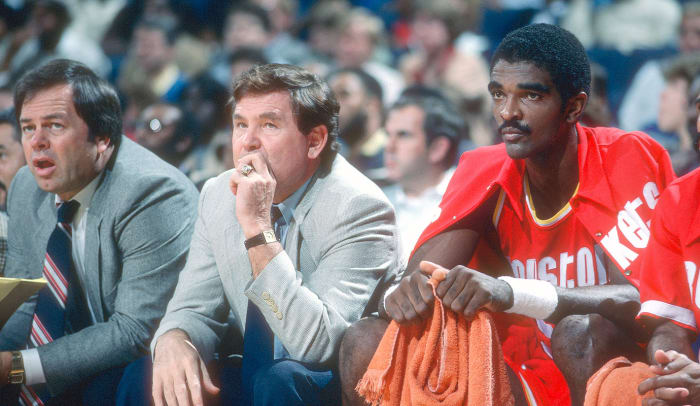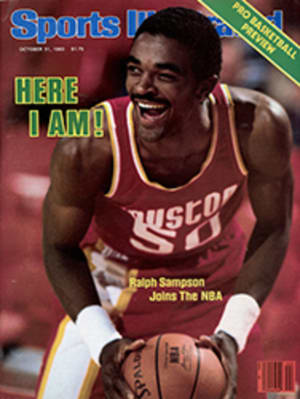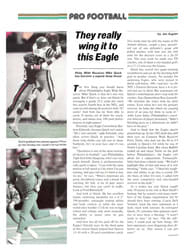It's Just a Matter of Time
Sometime near the end of this century, when his proper place in the history of the National Basketball Association has been secured, Ralph Sampson will sit back and laugh a little bit about his first few weeks as a pro. Exhibition season, indeed. Sampson, the Houston Rockets' prize center, was Exhibit A. Eight games, seven losses. Ralph will chuckle at his anemic .404 field-goal percentage, based on nights like four of 16 against the Trail Blazers in Portland. He'll smile at the memory of his gala homecoming at the University of Virginia's University Hall being ruined by four fouls in nine minutes, all picked up while fending off the hands—and elbows and backsides—of the Washington Bullets' Beef Brothers, McFilthy and McNasty themselves: Jeff Ruland and Rick Mahorn. He'll tell his kids about the time he threw an in-bounds pass against Milwaukee that struck a guy wire holding the scoreboard in place.
Time to develop is not readily conceded when you're 7'4" tall and a three-time NCAA Player of the Year. Especially when you're joining a team that won—no, weathered—only 14 games a season ago. Under those circumstances you're not just a tall and talented player. You become, as Sampson has discovered, "people's expectation of God Almighty."
It seems that some big man arrives almost every year in the NBA to expectations cut several sizes too large for him. About once a decade comes a true giant who can measure up to or even exceed them: Russell in '56; Alcindor/Abdul-Jabbar in '69; Walton in '74.
Will Sampson be the big man for the '80s? Or will he be another Chamberlain, with gaudy numbers but little to show for them? This could be a good time to place your bets, because, as Denver Nuggets Coach Doug Moe, who's won a few bucks at the gin rummy table, says of Sampson, "He's struggling a bit now, so we should all enjoy it while we can. But in a little while that guy's gonna be an absolute bitch to play against."
"He's like a baseball pitcher who's trying to throw seven or eight different pitches," says Pete Newell, the Golden State Warriors' talent consultant and acknowledged basketball guru. "Right now he just has to concentrate and master three or four things instead of doing everything. It'll take a little time."
That's the consensus throughout the league—it's just a matter of time. And no one knows that better than Sampson himself. "I feel that I'm improving," he says. "Every day I feel more and more comfortable with what I'm doing. But there's still time. Time is always there, enough time to do everything that must be done."
Fortunately for Sampson, his employers' vision also seems to extend beyond the here and now. From owner Charlie Thomas to General Manager Ray Patterson to new Coach Bill Fitch, the Rockets were content to treat the exhibition season as Sampson's incubation period, a time that will surely continue beyond Saturday's regular-season opener against San Antonio, beyond the team's first visit to Philadelphia in February, beyond even the beginning of the playoffs next April. "The big extravaganza that people seem to want won't be here," says Patterson. "I can see a sense of organizational progress, but there's no magic number of wins needed to satisfy me. I know we'll be better in November than we are now, and January will top that, and March will top that. If that means 29 wins, 35 wins, 43 wins, fine. If not, that's fine, too."
After all, the Rockets spent 13 months in purgatory just waiting to get to this point. It hurt them to trade Moses Malone to Philadelphia a year ago rather than pay him $2.2 million a year. But Moses' departure resulted in last season's abominable 14-68 record. It then took luck for the Rockets to beat the Indiana Pacers in the coin flip (heads was the winning call) for the right to pick Sampson first in the June draft. Had the Rockets kept Malone, they probably would have continued winning 45 or so games a season, then losing to a more talented club in the playoffs.
Today, however, everything feels brand-new in Houston. In Forward Caldwell Jones the Rockets have a proven winner, although he labored in obscurity after coming over from Philadelphia in the Malone deal, and the Rockets used a first-round draft pick obtained from Cleveland to get Louisville Forward Rodney McCray. As Patterson points out, "You may as well add Robert Reid and Fitch, too, because Ralph's being here is the reason why they both are here." Reid came back from a year's premature retirement (he had wanted to devote himself to the Pentecostal religion), while Fitch, who quit the Celtics last spring after four seasons, certainly needed more than 37-year-old Elvin Hayes to lure him to Houston.
The changes have already brightened the Rockets' financial picture. For the same money they would have had to pay Malone, they have Sampson plus three more potential starters and a new coach. At the box office, season-ticket sales are up 20% from last season, to more than 5,000. But Ralphonomics goes beyond season-ticket sales. Last year the Rockets played five preseason games; four of them were on the road, and they received minimal proceeds. This year they played seven exhibitions on the road and were able to demand a $30,000 minimum for each. The long-term plans, of course, include lots of SRO playoff crowds at the 15,816-seat Summit.
All because of Sampson. It took only a week in August for Ralph and his agent, Tom Collins (who also represents Abdul-Jabbar), to iron out the details of Sampson's four-year, $5 million contract with Thomas. And from the moment Sampson stepped onto the court the first day of rookie camp, it was obvious that he possessed immense potential. He was one of the better outside shooters, while in drills designed to emphasize the quick transition from offense to defense and vice versa, Sampson, gobbling up the court with his long, loping strides, was rarely caught out of position.
Of course, Houston was concerned with more than Sampson's ability to maneuver in drills. Throughout the exhibition season Fitch was concerned because Sampson had spent too much of his summer lifting weights and not enough time on the court. "There are times when Steve Stipanovich [the 6'11" center from Missouri taken second in the draft by Indiana] is going to look like a real find compared with Ralph because, I think, he's had more on-the-court experience," said Fitch.
"I don't think Ralph's played enough five-on-five. He's learned in three-on-three and in drills, but he's got to put it all together out on the court. The only way he's going to do that is in games."
But when Sampson made his first appearance in a Rocket uniform on Oct. 6 against the Mavericks in Dallas, it appeared that the transition from college player of the year to NBA superstar wouldn't be a problem at all. In 30 minutes he scored 24 points, with four assists, six rebounds and a pair of blocked shots. He even threw in a three-point shot for good measure. Despite the auspicious debut, three factors—each of no small importance—had to be considered. First, the Rockets lost the game 122-111. Second, Sampson scored most of his baskets over Dallas Center Pat Cummings, who stands only 6'9½". Third, because Houston had yet to install any kind of a set offense, most of Sampson's points were scored on jumpers from the outside.
That pattern continued through the preseason schedule, Sampson taking the ball outside and shooting over smaller men, with the Rockets falling short at the end. Sampson ended up as the Rockets' second-leading scorer (13.4) and leading rebounder (8.8), but he hardly played like the $5 million man. His nadir came in the game against the Bullets back at his beloved Charlottesville. Before a sellout crowd of adoring fans at University Hall, Sampson shot 0 for 5 in the first quarter, picked up four fouls after wrestling with Ruland and Mahorn, and was benched by Fitch. He finished with eight points and seven rebounds, fouling out after 22 minutes.
Score one for humility. "What I learned from that game is that I can't muscle up with the really big guys," says Sampson. "I can't blame them for what they did—if I were them I'd do the same thing to me. But what I can do in return is go around the contact and beat it that way. It doesn't make any sense for me to sit in there and get beaten up every night. If I go inside trying to push and shove, then I'm not playing my game."
Just how much inside and how much outside Sampson will be playing on offense has yet to be determined by Fitch, who has been more concerned with his other players' progress than with Sampson's. Much of Sampson's preseason was spent roaming between the high and low posts, just as he had done in college. For a time Sampson looked and felt awkward down low, both he and his new teammates unsure of how to get the ball to him inside through the tangle of defenders. "That's one of the big changes, playing against people close to my size all the time," says Sampson. "In college, someone would just throw the ball up in the air, and I'd jump up and grab it and do whatever I wanted to with it. Now I have to learn what the best angles are and the best spots to get the ball."
Fitch has been after Sampson to find a comfortable high-percentage shot. Initially, that turned out to be a variation of the 15-foot turnaround fadeaway—the shot that teammate Hayes has elevated to an art form over his 15 years—but it's not the sort of power move that a 7'4" NBA center ought to depend on.
"Ralph's problem is just a case of breaking old habits," says Newell. "Ralph saw so much zone in college that he had to drift to the outside to get off a shot. Now he has to get them off consistently from the middle."
Sampson has a wide assortment of inside moves to choose from. He's capable of hooking with either hand, and, of course, anytime he gets the ball within five feet of the basket he's likely to follow with a thundering stuff. But by having him go inside too often, the Rockets would diminish Sampson's effectiveness. Indeed, his best shot right now appears to be a short, turnaround spinning jumper from either baseline, just outside the lane. Extend that shot out a bit to 12 or 15 feet and you have a true scoring threat that would have to be honored by opposing centers, and that in turn would clear the lane for teammates cutting to the basket.
"With the mobility he has, you just know that he'd be great even if he were only 6'6"," says Denver Center Dan Issel, a fine outside shooter himself. "Houston should try to take advantage of it." Artis Gilmore of the San Antonio Spurs, a center who has made his reputation underneath the basket, agrees. "Each of the great centers in the league—Wilt, Russell, Kareem, Walton—all had something that made them unique, that set them apart from the rest. With Ralph, it's his mobility and outside capabilities. He could be the best big man ever at it."
Gilmore, for one, believes that Sampson's biggest problem at present is "all of the guys in the media and all the attention." Gilmore was once an Exhibit A himself. Well, the Rockets are doing all they can to keep the Sampson show from becoming a circus. When Sampson visits a city for the first time, a special press conference is arranged. Although he can be irritable and his answers are curt at times, Sampson for the most part has handled himself well, displaying a surprising touch of humor.
Asked at a press conference in Denver whether he was glad to be finished with the four-corner offenses and stalls that confronted him in college, Sampson brightened and nearly bellowed. "Yeah! Wouldn't you be?" Later he was asked to name his favorite player. Without missing a beat he replied, "Me."
So concerned was Fitch that Sampson not suffer from the sort of media mania that engulfed John Elway, the Denver Broncos' rookie quarterback, the coach collected many of the articles that appeared on Elway throughout the summer and made them into a scrapbook. The idea was to show Ralph that he wasn't alone under the public microscope.
So far, Sampson, who turned down NBA millions to stay in school and get his degree, has handled nearly everything thrown at him. Except time zones. "That may be the hardest thing to get used to," he says. "Being in different places is not the problem. You learn how to eat right and get enough sleep before a game. Where I get into trouble is making phone calls back home to the East and waking people up at night when I'm in the West somewhere." Between traveling and two-a-days, Sampson has yet to spend a full day in his new Houston condominium. Things have been so hectic that his mother is flying in from Virginia to complete the unpacking.
Sampson already has put the Rockets' 1-7 exhibition season behind him. "At first I would get upset, losing all the time," he says. "But the coaches convinced me that the preseason was just that—preseason—a time to get ready for the real thing."
But Sampson and the Rockets will have to endure losing for a while longer, at least until all the newcomers get acquainted and Fitch's lessons begin to take hold. By that time the season could be a month old, and even with the expanded playoffs, which will now include 16 teams instead of 12, the Rockets could be too far behind to catch up.
"Know what I think?" says San Antonio Coach Mo McHone. "The thing Sampson's really going to learn is that there are an awful lot of guys in this league who can score and that most of them are in the middle. What's going to determine how he stands in comparison with people like Moses and Kareem? Every night they go into the arena, they know that they have to damn near be the best player out on the floor. The defenses are set against them, the other team is keyed up to play them. But they do it anyway, nearly all the time. That's where Ralph has to get to."
It's all just a matter of time.
PHOTO
PETER
READ
MILLER
Sampson has size to spare, mobility and shooting touch. Now he needs some NBA game experience.
PHOTO
PETER READ
MILLER
The newest Rocket can lift off from any spot.
PHOTO
PETER READ
MILLER
Whether Sampson puts the ball up with his right hand...
PHOTO
PETER READ
MILLER
The big rookie's quick transition from offense to defense impresses Fitch, and Gilmore as well.
PHOTO
PETER READ MILLER
...or left, he's an imposing presence at center stage.
TWO
PHOTOS
PETER
READ
MILLER
Young, gifted and 7'4", Sampson might end up with the basketball world in his hands, but he'll surely have a few down moments along the way.


